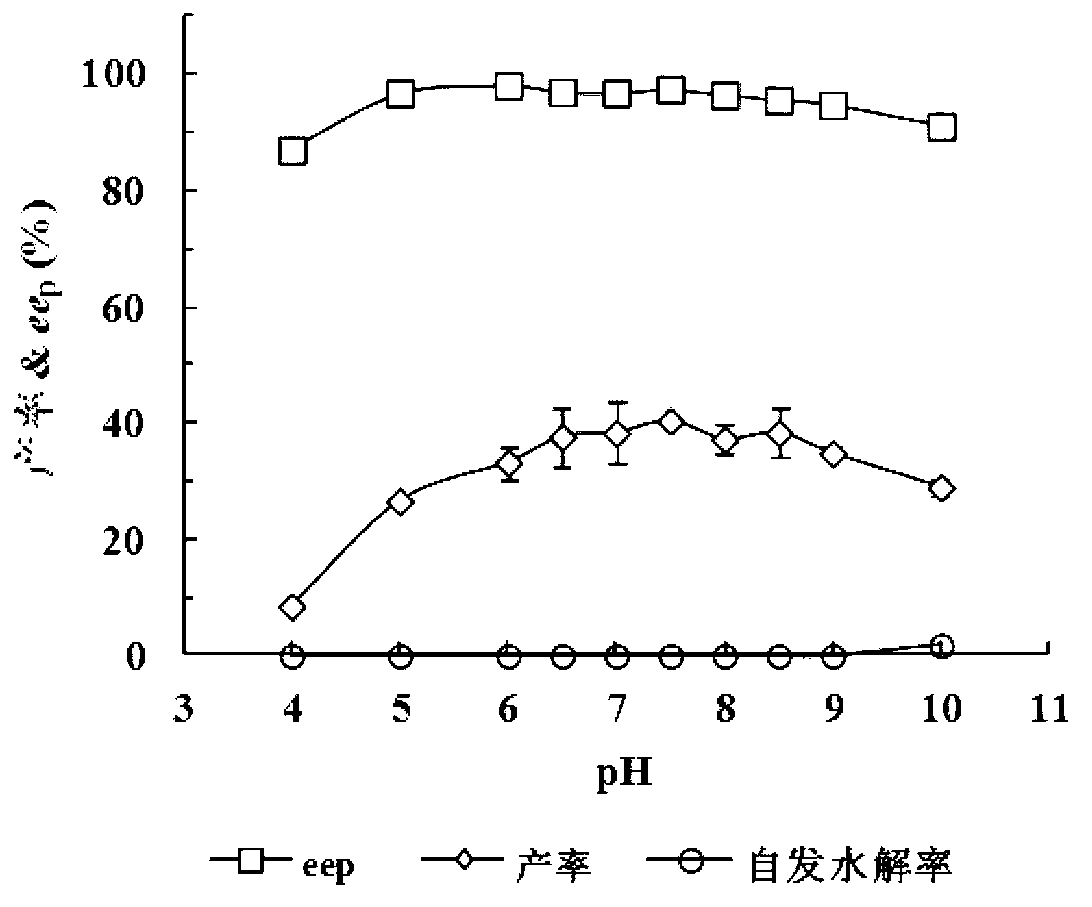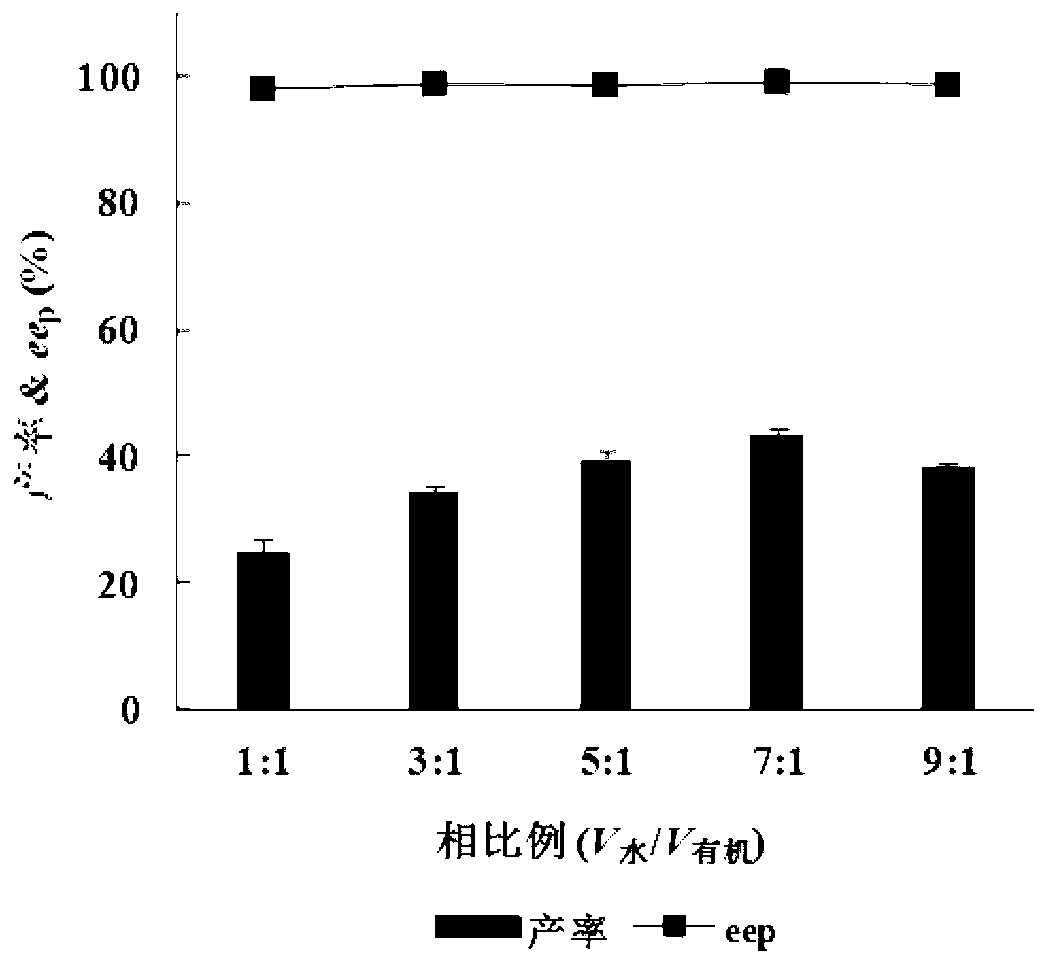Rhodococcus and application thereof in preparation of (S)-(+)-2,2-dimethylcyclopropane carboxylic acid
A technology of dimethyl cyclopropanecarboxylate and dimethyl cyclopropane, which is applied in the field of Rhodococcus ECU 1013, can solve the problem of high price, the enantioselectivity of Rhodococcus cannot meet the requirements of the pharmaceutical industry, and the number of repeated use is small, etc. question
- Summary
- Abstract
- Description
- Claims
- Application Information
AI Technical Summary
Problems solved by technology
Method used
Image
Examples
Embodiment 1
[0098] Example 1 Shake flask fermentation culture of Rhodococcus sp. ECU 1013 CGMCC No. 5911
[0099] Shake flask fermentation medium formula (g / L): glucose 5, yeast extract 5, NaCl 1, KH 2 PO 4 1. MgSO 4 0.2, CaCl 2 0.1, pH 6.0, prepared with tap water, sterilized at 121°C for 20 minutes. Take the Rhodococcus slant preserved at 4°C, pick a loop and inoculate it into a 500mL Erlenmeyer flask containing a 100mL shake flask fermentation medium, shake culture at 30°C and 180rpm for 36h, the cell viability of the fermentation broth is about 3.2u / L. After the cultivation, the cells were collected by centrifugation at 8800 rpm for 10 minutes, washed twice with saline, and stored at 4°C for later use. The cell viability unit (u) is defined as: under the conditions of 30°C and pH 7.0, the hydrolysis of methyl 2,2-dimethylcyclopropane formate to 1.0 μmol of 2,2-dimethylcyclopropane formic acid is produced every hour. The amount of cells needed.
Embodiment 2
[0100] Example 2 Fermentation tank culture of Rhodococcus sp. ECU 1013 CGMCC No. 5911 and preparation of crude Rhodococcus esterase powder
[0101] Fermentation medium formula (g / L): glucose 20, yeast extract 10, NaCl5, KH 2 PO 4 5. MgSO 4 2. CaCl 2 1, pH 7.5, 121 ℃ high temperature sterilization for 20 minutes. The seed liquid medium formula is the same as the fermentation medium. Take the Rhodococcus slant preserved at 4°C, pick a loop and inoculate it into a 500mL Erlenmeyer flask containing 100mL seed liquid culture medium, and culture it for 12h at 35°C and 180rpm with shaking. Three bottles of seed liquid (300ml) were connected to a 5L fermentor containing 3L of fermentation medium, and fermentation was carried out at 30°C. Aeration: 0.8~1.2vvm, pH is not controlled during fermentation. After culturing for 25 hours, the cell viability of the fermentation broth reached 11u / L, and the cells were collected by centrifugation at 9000 rpm, and the wet weight of the bacteria rea...
Embodiment 3
[0103] Example 3 Rhodococcus sp. ECU 1013 CGMCC No. 5911 cells catalyze the enzymatic hydrolysis of ethyl 2,2-dimethylcyclopropane carboxylate
[0104] Take 0.5 g of the wet cells obtained in Example 1 and suspend them in 10 mL of phosphate buffer (100 mM, pH 7.0), and add 5 mM 2,2-dimethylcyclopropane ethyl carboxylate. The reaction mixture is kept at 30°C, 180 rpm Shake for 72h. After the reaction is over, take 100μL of the reaction solution and add 20% H 2 SO 4 Adjust the pH of the solution to <2, add an equal volume of ethyl acetate to extract the product and substrate, and analyze the ee value and yield of the product through the gas phase. The ee value of the product was 83.9%, and the yield was 21.2%.
PUM
| Property | Measurement | Unit |
|---|---|---|
| optical purity | aaaaa | aaaaa |
| optical purity | aaaaa | aaaaa |
| optical purity | aaaaa | aaaaa |
Abstract
Description
Claims
Application Information
 Login to View More
Login to View More - R&D
- Intellectual Property
- Life Sciences
- Materials
- Tech Scout
- Unparalleled Data Quality
- Higher Quality Content
- 60% Fewer Hallucinations
Browse by: Latest US Patents, China's latest patents, Technical Efficacy Thesaurus, Application Domain, Technology Topic, Popular Technical Reports.
© 2025 PatSnap. All rights reserved.Legal|Privacy policy|Modern Slavery Act Transparency Statement|Sitemap|About US| Contact US: help@patsnap.com



